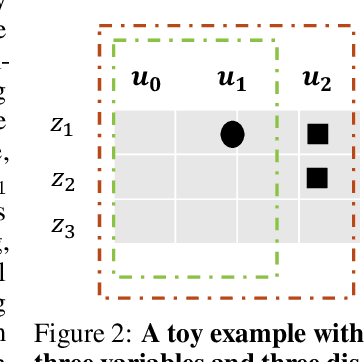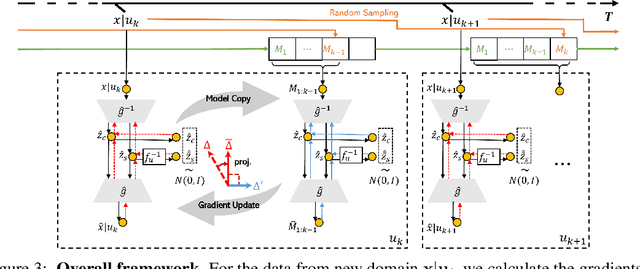Yifan Shen
Reflection-Window Decoding: Text Generation with Selective Refinement
Feb 05, 2025



Abstract:The autoregressive decoding for text generation in large language models (LLMs), while widely used, is inherently suboptimal due to the lack of a built-in mechanism to perform refinement and/or correction of the generated content. In this paper, we consider optimality in terms of the joint probability over the generated response, when jointly considering all tokens at the same time. We theoretically characterize the potential deviation of the autoregressively generated response from its globally optimal counterpart that is of the same length. Our analysis suggests that we need to be cautious when noticeable uncertainty arises during text generation, which may signal the sub-optimality of the generation history. To address the pitfall of autoregressive decoding for text generation, we propose an approach that incorporates a sliding reflection window and a pausing criterion, such that refinement and generation can be carried out interchangeably as the decoding proceeds. Our selective refinement framework strikes a balance between efficiency and optimality, and our extensive experimental results demonstrate the effectiveness of our approach.
Controllable Video Generation with Provable Disentanglement
Feb 04, 2025



Abstract:Controllable video generation remains a significant challenge, despite recent advances in generating high-quality and consistent videos. Most existing methods for controlling video generation treat the video as a whole, neglecting intricate fine-grained spatiotemporal relationships, which limits both control precision and efficiency. In this paper, we propose Controllable Video Generative Adversarial Networks (CoVoGAN) to disentangle the video concepts, thus facilitating efficient and independent control over individual concepts. Specifically, following the minimal change principle, we first disentangle static and dynamic latent variables. We then leverage the sufficient change property to achieve component-wise identifiability of dynamic latent variables, enabling independent control over motion and identity. To establish the theoretical foundation, we provide a rigorous analysis demonstrating the identifiability of our approach. Building on these theoretical insights, we design a Temporal Transition Module to disentangle latent dynamics. To enforce the minimal change principle and sufficient change property, we minimize the dimensionality of latent dynamic variables and impose temporal conditional independence. To validate our approach, we integrate this module as a plug-in for GANs. Extensive qualitative and quantitative experiments on various video generation benchmarks demonstrate that our method significantly improves generation quality and controllability across diverse real-world scenarios.
Flow: A Modular Approach to Automated Agentic Workflow Generation
Jan 14, 2025



Abstract:Multi-agent frameworks powered by large language models (LLMs) have demonstrated great success in automated planning and task execution. However, the effective adjustment of Agentic workflows during execution has not been well-studied. A effective workflow adjustment is crucial, as in many real-world scenarios, the initial plan must adjust to unforeseen challenges and changing conditions in real-time to ensure the efficient execution of complex tasks. In this paper, we define workflows as an activity-on-vertex (AOV) graphs. We continuously refine the workflow by dynamically adjusting task allocations based on historical performance and previous AOV with LLM agents. To further enhance system performance, we emphasize modularity in workflow design based on measuring parallelism and dependence complexity. Our proposed multi-agent framework achieved efficient sub-task concurrent execution, goal achievement, and error tolerance. Empirical results across different practical tasks demonstrate dramatic improvements in the efficiency of multi-agent frameworks through dynamic workflow updating and modularization.
Symmetry Adapted Residual Neural Network Diabatization: Conical Intersections in Aniline Photodissociation
Nov 03, 2024Abstract:We present a symmetry adapted residual neural network (SAResNet) diabatization method to construct quasi-diabatic Hamiltonians that accurately represent ab initio adiabatic energies, energy gradients, and nonadiabatic couplings for moderate sized systems. Our symmetry adapted neural network inherits from the pioneering symmetry adapted polynomial and fundamental invariant neural network diabatization methods to exploit the power of neural network along with the transparent symmetry adaptation of polynomial for both symmetric and asymmetric irreducible representations. In addition, our symmetry adaptation provides a unified framework for symmetry adapted polynomial and symmetry adapted neural network, enabling the adoption of the residual neural network architecture, which is a powerful descendant of the pioneering feedforward neural network. Our SAResNet is applied to construct the full 36-dimensional coupled diabatic potential energy surfaces for aniline N-H bond photodissociation, with 2,269 data points and 32,640 trainable parameters and 190 cm-1 root mean square deviation in energy. In addition to the experimentally observed {\pi}{\pi}* and {\pi}Rydberg/{\pi}{\sigma}* states, a higher state (HOMO - 1 {\pi} to Rydberg/{\sigma}* excitation) is found to introduce an induced geometric phase effect thus indirectly participate in the photodissociation process.
Continual Learning of Nonlinear Independent Representations
Aug 11, 2024



Abstract:Identifying the causal relations between interested variables plays a pivotal role in representation learning as it provides deep insights into the dataset. Identifiability, as the central theme of this approach, normally hinges on leveraging data from multiple distributions (intervention, distribution shift, time series, etc.). Despite the exciting development in this field, a practical but often overlooked problem is: what if those distribution shifts happen sequentially? In contrast, any intelligence possesses the capacity to abstract and refine learned knowledge sequentially -- lifelong learning. In this paper, with a particular focus on the nonlinear independent component analysis (ICA) framework, we move one step forward toward the question of enabling models to learn meaningful (identifiable) representations in a sequential manner, termed continual causal representation learning. We theoretically demonstrate that model identifiability progresses from a subspace level to a component-wise level as the number of distributions increases. Empirically, we show that our method achieves performance comparable to nonlinear ICA methods trained jointly on multiple offline distributions and, surprisingly, the incoming new distribution does not necessarily benefit the identification of all latent variables.
From Orthogonality to Dependency: Learning Disentangled Representation for Multi-Modal Time-Series Sensing Signals
May 25, 2024



Abstract:Existing methods for multi-modal time series representation learning aim to disentangle the modality-shared and modality-specific latent variables. Although achieving notable performances on downstream tasks, they usually assume an orthogonal latent space. However, the modality-specific and modality-shared latent variables might be dependent on real-world scenarios. Therefore, we propose a general generation process, where the modality-shared and modality-specific latent variables are dependent, and further develop a \textbf{M}ulti-mod\textbf{A}l \textbf{TE}mporal Disentanglement (\textbf{MATE}) model. Specifically, our \textbf{MATE} model is built on a temporally variational inference architecture with the modality-shared and modality-specific prior networks for the disentanglement of latent variables. Furthermore, we establish identifiability results to show that the extracted representation is disentangled. More specifically, we first achieve the subspace identifiability for modality-shared and modality-specific latent variables by leveraging the pairing of multi-modal data. Then we establish the component-wise identifiability of modality-specific latent variables by employing sufficient changes of historical latent variables. Extensive experimental studies on multi-modal sensors, human activity recognition, and healthcare datasets show a general improvement in different downstream tasks, highlighting the effectiveness of our method in real-world scenarios.
On the Identification of Temporally Causal Representation with Instantaneous Dependence
May 24, 2024


Abstract:Temporally causal representation learning aims to identify the latent causal process from time series observations, but most methods require the assumption that the latent causal processes do not have instantaneous relations. Although some recent methods achieve identifiability in the instantaneous causality case, they require either interventions on the latent variables or grouping of the observations, which are in general difficult to obtain in real-world scenarios. To fill this gap, we propose an \textbf{ID}entification framework for instantane\textbf{O}us \textbf{L}atent dynamics (\textbf{IDOL}) by imposing a sparse influence constraint that the latent causal processes have sparse time-delayed and instantaneous relations. Specifically, we establish identifiability results of the latent causal process based on sufficient variability and the sparse influence constraint by employing contextual information of time series data. Based on these theories, we incorporate a temporally variational inference architecture to estimate the latent variables and a gradient-based sparsity regularization to identify the latent causal process. Experimental results on simulation datasets illustrate that our method can identify the latent causal process. Furthermore, evaluations on multiple human motion forecasting benchmarks with instantaneous dependencies indicate the effectiveness of our method in real-world settings.
Practical Region-level Attack against Segment Anything Models
Apr 12, 2024Abstract:Segment Anything Models (SAM) have made significant advancements in image segmentation, allowing users to segment target portions of an image with a single click (i.e., user prompt). Given its broad applications, the robustness of SAM against adversarial attacks is a critical concern. While recent works have explored adversarial attacks against a pre-defined prompt/click, their threat model is not yet realistic: (1) they often assume the user-click position is known to the attacker (point-based attack), and (2) they often operate under a white-box setting with limited transferability. In this paper, we propose a more practical region-level attack where attackers do not need to know the precise user prompt. The attack remains effective as the user clicks on any point on the target object in the image, hiding the object from SAM. Also, by adapting a spectrum transformation method, we make the attack more transferable under a black-box setting. Both control experiments and testing against real-world SAM services confirm its effectiveness.
Towards Adversarially Robust Dataset Distillation by Curvature Regularization
Mar 15, 2024Abstract:Dataset distillation (DD) allows datasets to be distilled to fractions of their original size while preserving the rich distributional information so that models trained on the distilled datasets can achieve a comparable accuracy while saving significant computational loads. Recent research in this area has been focusing on improving the accuracy of models trained on distilled datasets. In this paper, we aim to explore a new perspective of DD. We study how to embed adversarial robustness in distilled datasets, so that models trained on these datasets maintain the high accuracy and meanwhile acquire better adversarial robustness. We propose a new method that achieves this goal by incorporating curvature regularization into the distillation process with much less computational overhead than standard adversarial training. Extensive empirical experiments suggest that our method not only outperforms standard adversarial training on both accuracy and robustness with less computation overhead but is also capable of generating robust distilled datasets that can withstand various adversarial attacks.
When and How: Learning Identifiable Latent States for Nonstationary Time Series Forecasting
Feb 20, 2024



Abstract:Temporal distribution shifts are ubiquitous in time series data. One of the most popular methods assumes that the temporal distribution shift occurs uniformly to disentangle the stationary and nonstationary dependencies. But this assumption is difficult to meet, as we do not know when the distribution shifts occur. To solve this problem, we propose to learn IDentifiable latEnt stAtes (IDEA) to detect when the distribution shifts occur. Beyond that, we further disentangle the stationary and nonstationary latent states via sufficient observation assumption to learn how the latent states change. Specifically, we formalize the causal process with environment-irrelated stationary and environment-related nonstationary variables. Under mild conditions, we show that latent environments and stationary/nonstationary variables are identifiable. Based on these theories, we devise the IDEA model, which incorporates an autoregressive hidden Markov model to estimate latent environments and modular prior networks to identify latent states. The IDEA model outperforms several latest nonstationary forecasting methods on various benchmark datasets, highlighting its advantages in real-world scenarios.
 Add to Chrome
Add to Chrome Add to Firefox
Add to Firefox Add to Edge
Add to Edge